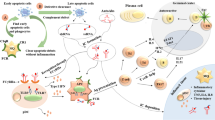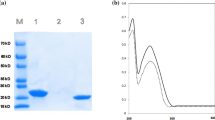Abstract
Systemic lupus erythematosus (SLE) is a multisystem autoimmune disease characterized by circulating and tissue fixed autoantibodies reactive with self-antigens, including nucleic acid and other nuclear components. The pathways by which these autoantibodies act as a pathogenic factor remain elusive. Present study has investigated the role of estrogens in SLE etiopathogenesis. Estrogen-modified DNA [4-OHE2-Cu(II)-DNA] showed single- and double-strand breaks, hyperchromicity, decrease in Tm, and modification of bases. The 4-OHE2-Cu(II)-DNA exhibited increased binding with naturally occurring anti-DNA autoantibodies as compared to the unmodified native form (P < 0.001) as assessed by ELISA, quantitative precipitin titration, and gel retardation assay. The relative affinity of anti-DNA antibodies for modified and native DNA was in the order of 2.1 × 10−7 M and 1.3 × 10−6 M, respectively. The data suggested that DNA modified with 4-OHE2 and Cu(II) may be one of the factors for the induction of circulating anti-DNA autoantibodies in SLE.





Similar content being viewed by others

References
Cutolo M, Capellino S, Sulli A, Serioli B, Secchi ME, Villaggio B et al (2006) Estrogens and autoimmune diseases. Ann N Y Acad Sci 1089:538–547. doi:10.1196/annals.1386.043
Gomez CR, Plackett TP, Kovacs EJ (2007) Aging and estrogen: modulation of inflammatory responses after injury. Exp Gerontol 42:451–456. doi:10.1016/j.exger.2006.11.013
Straub RH (2007) The Complex Role of Estrogens in Inflammation. Endocr Rev 28:521–574. doi:10.1210/er.2007-0001
Cohen-Solal JF, Jeganathan V, Grimaldi CM, Peeva E, Diamond B (2006) Sex hormones and SLE: influencing the fate of autoreactive B cells. Curr Top Microbiol Immunol 305:67–88
Mc Murray RW (2001) Sex hormones in the pathogenesis of systemic lupus erythematosus. Front Biosci 6:E193–E206. doi:10.2741/McMurray
Jacobson DL, Gange SJ, Rose NR, Graham NMH (1997) Epidemiology and estimated population burden of selected autoimmune disease in the United States. Clin Immunol Immunopathol 84:223–243. doi:10.1006/clin.1997.4412
Grossman C, Roselle G, Mendenhall C (1991) Sex steroid regulation of autoimmunity. J Steroid Biochem Mol Biol 40:649–659. doi:10.1016/0960-0760(91)90287-F
Weidler C, Harle P, Schedel J, Schmidt M, Scholmerich J, Straub RH (2004) Patients with rheumatoid arthritis and systemic lupus erythematosus have increased renal excretion of mitogenic estrogen in relation to endogenous antiestrogens. J Rheumatol 31:489–494
Lahita RG, Bradlow HL, Kunal HG, Fishman J (1979) Alteration of estrogen metabolism in systemic lupus erythematosus. Arthritis Rheum 22:1195–1198. doi:10.1002/art.1780221106
Castagnetta L, Carruba G, Granata OM, Stefano R, Miele M, Schmidt M et al (2003) Increased estrogen formation and estrogen to androgen ratio in the SF of patients with rheumatoid arthritis. J Rheumatol 30:2597–2605
Lahita RG (1996) The connective tissue diseases and the overall influence of gender. Int J Fertil Menopausal Stud 41:156–160
Bremner I, Beattie JH (1995) Copper and zinc metabolism in health and disease: speciation and interactions. Proc Nutr Soc 54:489–499. doi:10.1079/PNS19950017
Haschke F, Ziegler EE, Edwards BB, Fomon SJ (1986) Effect of iron fortification of infant formula on trace mineral absorption. J Pediatr Gastroenterol Nutr 5:768–773. doi:10.1097/00005176-198609000-00018
Harris ED, Percival SS (1991) A role for ascorbic acid in copper transport. Am J Clin Nutr 54:1193S–1197S
Saltman PD, Strause LG (1993) The role of trace minerals in osteoporosis. J Am Coll Nutr 12:384–389
Cashman KD, Baker A, Ginty F, Strain JJ, Bonham MP, O’Connor JM et al (2001) No effect of copper supplementation on biochemical markers of bone metabolism in healthy young adult females despite apparently improved copper status. Eur J Clin Nutr 55:525–553. doi:10.1038/sj.ejcn.1601177
Manson JJ, Isenberg DA (2003) The pathogenesis of systemic lupus erythematosus. Neth J Med 61:343–346
Cameron JJ (1999) Clinical manifestations of lupus nephritis. In: Lewis EJ, Schwartz MM, Korbet SM (eds) Lupus nephritis. Oxford University Press, Oxford, pp 159–184
Waldman M, Madaio MP (2005) Pathogenic autoantibodies in lupus nephritis. Lupus 14:19–24. doi:10.1191/0961203305lu2054oa
Khan WA, Moinuddin (2006) Binding Characteristics of SLE anti-DNA autoantibodies to Catecholestrogen-modified DNA. Scand J Immunol 64:677–683. doi:10.1111/j.1365-3083.2006.01855.x
Khan WA, Alam K, Moinuddin (2007) Catechol-estrogen modified DNA: A better antigen for cancer autoantibody. Arch Biochem Biophys 465:293–300. doi:10.1016/j.abb.2007.06.006
Al Arfaj AS, Chawdhary AR, Khalil N, Ali R (2007) Immunogenicity of singlet oxygen modified human DNA: implication for anti-DNA antibodies in systemic lupus erythematosus. Clin Immunol 124:83–89. doi:10.1016/j.clim.2007.03.548
Mansoor F, Ali A, Ali R (2005) Binding of circulating SLE autoantibodies to oxygen free radical damaged chromatin. Autoimmunity 38:431–438. doi:10.1080/08916930500288596
Gark DK, Ali R, Moinuddin (2003) Hydroxyl modification of polyguanilic acid: role of modified guanine in circulating SLE anti-DNA autoantibodies. Immunol Invest 32:187–199. doi:10.1081/IMM-120022978
Waris G, Alam K (2004) Immunogenicity of superoxide radical modified-DNA: studies on induced antibodies and SLE anti-DNA autoantibodies. Life Sci 75:2633–2642. doi:10.1016/j.lfs.2004.04.034
Habib S, Ali R, Moinuddin (2006) Peroxynitrite-modified DNA: a better antigen for systemic lupus erythematosus anti-DNA autoantibodies. Biotechnol Appl Biochem 43:65–70. doi:10.1042/BA20050156
Habib S, Ali R, Moinuddin (2005) Acquired antigenicity of DNA after modification with peroxynitrite. Int J Biol Macromol 35:221–225. doi:10.1016/j.ijbiomac.2005.02.005
Arnett FC, Edworthy TA, Bloch DA, Mcshaie DJ, Fries JF, Cooper NS et al (1988) The American Rheumatism Association 1987 revised criteria for the classification of rheumatoid arthritis. Arthritis Rheum 31:315–324. doi:10.1002/art.1780310302
Hasan R, Ali R (1990) Antibody recognition of common epitopes on Z-DNA and native DNA brominated under high salt. Biochem Int 20:1077–1088
Ali R, Alam K (2002) Evaluation of antibodies against free radical modified DNA by ELISA. In: Armstrong D (ed) Oxidative stress biomarkers and antioxidants protocols. Human Press, New Jersey, pp 171–181
Dixit K, Ali R (2001) Antigen binding characteristics of antibodies induced against nitric oxide modified plasmid DNA. Biochim Biophys Acta 1528:1–8
Burton K (1956) A study of the conditions and mechanisms of the diphenylamine reaction for the colorimetric estimation of deoxyribonucleic acid. Biochem J 62:315–323
Bradford MM (1976) A rapid and sensitive method for quantitation of micrograms quantity of protein utilizing the principle of protein dye binding. Anal Biochem 72:248–254. doi:10.1016/0003-2697(76)90527-3
Langmuir I (1918) The adsorption of gases on plane surface glass, mica and platinum. J Am Chem Soc 40:1361–1403. doi:10.1021/ja02242a004
Jansson G (1985) Formation of antibodies to native DNA in rats after administration of native DNA treated with xanthine-xanthine oxidase system. Free Radic Res Commun 1:119–122. doi:10.3109/10715768509056544
Riemekasten G, Hahn BH (2005) Key autoantigens in SLE. Rheumatology 44:975–982. doi:10.1093/rheumatology/keh688
Mok CC, Lau CS (2003) Pathogenesis of systemic lupus erythematosus. J Clin Pathol 56:481–490. doi:10.1136/jcp. 56.7.481
Agarwal K, Sharma A, Taluder G (1989) Effects of copper on mammalian cell components. Chem Biol Interact 69:1–16. doi:10.1016/0009-2797(89)90094-X
Bryan SE, Vizard DL, Beary DA, Biche RA, Hardy KJ (1981) Partitioning of zinc and copper within sub-nuclear nucleoprotein particles. Nucleic Acids Res 9:5811–5823. doi:10.1093/nar/9.21.5811
Whitehouse MW (1976) Ambivalent role of copper in inflammatory disorders. Inflamm Res 6:201–206
Brewer GJ (2005) Anti-copper therapy against cancer and diseases of inflammation and fibrosis. Drug Discov Today 10:1103–1109. doi:10.1016/S1359-6446(05)03541-5
Zhu BT, Conney AH (1998) Functional role of estrogen metabolism in target cells: review and perspectives. Carcinogenesis 19:1–27. doi:10.1093/carcin/19.1.1
Cavalieri E, Frenkel K, Liehr JG, Rogan E, Roy D (2000) Estrogen as endogenous genotoxic agents—DNA adducts and mutation. J Natl Cancer Inst Monogr 27:75–93
Cutolo M, Sulli A, Seriolo B, Accardo S, Masi AT (1995) Estrogens, the immune response and autoimmunity. Clin Exp Rheumatol 13:217–226
Stollar BD (1989) Immunochemistry of DNA. Int Rev Immunol 5:1–22. doi:10.3109/08830188909086987
Acknowledgments
The authors thank Prof. Rashid Ali for his continuous help and support. We are greatly thankful to him for providing lab facility and constructive discussions during this work.
Author information
Authors and Affiliations
Corresponding author
Rights and permissions
About this article
Cite this article
Khan, W.A., Habib, S., Khan, W.A. et al. Enhanced binding of circulating SLE autoantibodies to catecholestrogen-copper-modified DNA. Mol Cell Biochem 315, 143–150 (2008). https://doi.org/10.1007/s11010-008-9798-1
Received:
Accepted:
Published:
Issue Date:
DOI: https://doi.org/10.1007/s11010-008-9798-1



